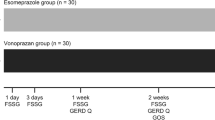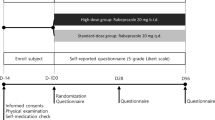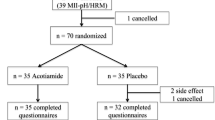Abstract
Background and Aim
Reflux symptoms in patients with non-erosive reflux disease (NERD) cannot be easily controlled by treatment with proton pump inhibitors (PPI). The anti-inflammatory function of rebamipide may be effective for protecting the esophageal mucosa. This prospective randomized multicenter placebo-controlled study was performed to clarify the efficacy of rebamipide for NERD patients whose reflux symptoms were refractory to PPI treatment.
Methods
One hundred forty-nine patients were enrolled on the basis of a QUEST score of over 6 and absence of endoscopically proven esophageal mucosal breaks. All the patients were initially administered 15 mg of lansoprazole for 4 weeks, and the symptoms were then assessed using QUEST and GSRS. PPI-refractory patients were randomly assigned to administration of rebamipide or placebo t.i.d. for 4 weeks.
Results
Three of the 149 patients were lost to follow-up, and 60 among the remaining 146 patients were found to be PPI-refractory. Among these PPI-refractory patients, 31 were randomly assigned to a rebamipide group and 29 to a placebo group. At the end of drug administration, the QUEST and GSRS scores did not differ between the rebamipide and placebo groups, although a significantly higher proportion of patients in the rebamipide group showed amelioration of abdominal pain and diarrhea.
Conclusion
Administration of rebamipide cannot effectively control reflux symptoms in NERD patients whose symptoms are refractory to PPI therapy.


Similar content being viewed by others
References
Dodds WJ, Hogan WJ, Helm JF, Dent J. Pathogenesis of reflux esophagitis. Gastroenterology. 1981;81:376–394.
Moayyedi P, Talley NJ. Gastro-oesophageal reflux disease. Lancet. 2006;367:2086–2100.
Fass R, Fennerty MB, Vakil N. Nonerosive reflux disease—current concepts and dilemmas. Am J Gastroenterol. 2001;96:303–314.
Kennedy T, Jones R. The prevalence of gastro-oesophageal reflux symptoms in a UK population and the consultation behaviour of patients with these symptoms. Aliment Pharmacol Ther. 2000;14:1589–1594.
Furukawa N, Iwakiri R, Koyama T, et al. Proportion of reflux esophagitis in 6,010 Japanese adults: prospective evaluation by endoscopy. J Gastroenterol. 1999;3:441–444.
Amano K, Adachi K, Katsube T, Watanabe M, Kinoshita Y. Role of hiatus hernia and gastric mucosal atrophy in the development of reflux esophagitis in the elderly. J Gastroenterol Hepatol. 2001;16:132–136.
Mishima I, Adachi K, Arima N, et al. Prevalence of endoscopically negative and positive gastroesophageal reflux disease in the Japanese. Scand J Gastroenterol. 2005;40:1005–1009.
Moki F, Kusano M, Mizuide M, et al. Association between reflux oesophagitis and features of the metabolic syndrome in Japan. Aliment Pharmacol Ther. 2007;26:1069–1075.
Wong BC, Kinoshita Y. Systematic review on epidemiology of gastroesophageal reflux disease in Asia. Clin Gastroenterol Hepatol. 2006;4:398–407.
Dimenas E. Methodological aspects of evaluation of quality of life in upper gastrointestinal diseases. Scand J Gastroenterol. 1993;28:18–21.
Chiba N, De Gara CJ, Wilkinson JM, Hunt RH. Speed of healing and symptom relief in grade II–IV gastroesophageal reflux disease: a meta-analysis. Gastroenterology. 1997;112:1798–1810.
Bate CM, Green JR, Axon AT, et al. Omeprazole is more effective than cimetidine for the relief of all grades of gastro-oesophageal reflux disease-associated heartburn, irrespective of the presence or absence of endoscopic oesophagitis. Aliment Pharmacol Ther. 1997;11:755–763.
Lind T, Havelund T, Carlsson R, et al. Heartburn without oesophagitis: efficacy of omeprazole therapy and features determining therapeutic response. Scand J Gastroenterol. 1997;32:974–979.
Dean BB, Gano AD Jr, Knight K, Ofman JJ, Fass R. Effectiveness of proton pump inhibitors in nonerosive reflux disease. Clin Gastroenterol Hepatol. 2004;2:656–664.
Miwa H, Sasaki M, Furuta T, et al. Efficacy of rabeprazole on heartburn symptom resolution in patients with non-erosive and erosive gastro-oesophageal reflux disease: a multicenter study from Japan. Aliment Pharmacol Ther. 2007;26:69–77.
Lee ES, Kim N, Lee SH, et al. Comparison of risk factors and clinical responses to proton pump inhibitors in patients with erosive oesophagitis and non-erosive reflux disease. Aliment Pharmacol Ther. 2009;30:154–164.
Yamasaki K, Kanbe T, Chijiwa T, Ishiyama H, Morita S. Gastric mucosal protection by OPC-12759, a novel antiulcer compound, in the rat. Eur J Pharmacol. 1987;142:23–29.
Ogino K, Hobara T, Ishiyama H, et al. Antiulcer mechanism of action of rebamipide, a novel antiulcer compound, on diethyl–dithiocarbamate-induced antral gastric ulcers in rats. Eur J Pharmacol. 1992;212:9–13.
Sun WH, Tsuji S, Tsujii M, et al. Induction of cyclooxygenase-2 in rat gastric mucosa by rebamipide, a mucoprotective agent. J Pharmacol Exp Ther. 2000;295:447–452.
Suetsugu H, Ishihara S, Moriyama N, et al. Effect of rebamipide on prostaglandin EP4 receptor gene expression in rat gastric mucosa. J Lab Clin Med. 2000;136:50–57.
Arakawa T, Kobayashi K, Yoshikawa T, Tarnawski A. Rebamipide: overview of its mechanisms of action and efficacy in mucosal protection and ulcer healing. Dig Dis Sci. 1998;43:5S–13S.
Park SH, Cho CS, Lee OY, et al. Comparison of prevention of NSAID-induced gastrointestinal complications by rebamipide and misoprostol: a randomized, multicenter, controlled trial—STORM STUDY. J Clin Biochem Nutr. 2007;40:148–155.
Suzuki M, Miura S, Mori M, et al. Rebamipide, a novel anti-ulcer agent, attenuates Helicobacter pylori induced gastric mucosal cell injury associated with neutrophil derived oxidants. Gut. 1994;35:1375–1378.
Yoshikawa T, Naito Y, Tanigawa T, Kondo M. Free radical scavenging activity of the novel anti-ulcer agent rebamipide studied by electron spin resonance. Arzneimittelforschung. 1993;43:363–366.
Naito Y, Yoshikawa T, Tanigawa T, et al. Hydroxyl radical scavenging by rebamipide and related compounds: electron paramagnetic resonance study. Free Radic Biol Med. 1995;18:117–123.
Aihara M, Azuma A, Takizawa H, et al. Molecular analysis of suppression of interleukin-8 production by rebamipide in Helicobacter pylori-stimulated gastric cancer cell lines. Dig Dis Sci. 1998;43:174S–180S.
Katada K, Yoshida N, Isozaki Y, et al. Prevention by rebamipide of acute reflux esophagitis in rats. Dig Dis Sci. 2005;50:S97–S103.
Yoshida N, Kamada K, Tomatsuri N, et al. Management of recurrence of symptoms of gastroesophageal reflux disease: synergistic effect of rebamipide with 15 mg lansoprazole. Dig Dis Sci. 2010;55:3393–3398.
Carlsson R, Dent J, Bolling-Sternevald E, et al. The usefulness of a structured questionnaire in the assessment of symptomatic gastroesophageal reflux disease. Scand J Gastroenterol. 1998;33:1023–1029.
Revicki DA, Wood M, Wiklund I, Crawley J. Reliability and validity of the gastrointestinal symptom rating scale in patients with gastroesophageal reflux disease. Qual Life Res. 1998;7:75–83.
Miwa H, Osada T, Nagahara A, et al. Effect of a gastro-protective agent, rebamipide, on symptom improvement in patients with functional dyspepsia: a double blind placebo-controlled study in Japan. J Gastroenterol Hepatol. 2006;21:1826–1831.
Talley NJ, Riff DS, Schwartz H, Marcuard SP. Double-blind placebo-controlled multicentre studies of rebamipide. Aliment Pharmacol Ther. 2001;15:1603–1611.
Wu JC, Cheung CM, Wong VW, Sung JJ. Distinct clinical characteristics between patients with nonerosive reflux disease and those with reflux esophagitis. Clin Gastroenterol Hepatol. 2007;5:690–695.
Adachi K, Matsumori Y, Fujisawa T, et al. Symptomatic diversity of patients with reflux esophagitis: effect of omeprazole treatment. J Clin Biochem Nutr. 2006;39:46–54.
Noh YW, Jung HK, Kim SE, Jung SA. Overlap of erosive and non-erosive reflux diseases with functional gastrointestinal disorders according to Rome III criteria. J Neurogastroenterol Motil. 2010;16:148–156.
Rodriguez-Stanley S, Robinson M, Earnest DL, Greenwood-Van Meerveld B, Miner PB Jr. Esophageal hypersensitivity may be a major cause of heartburn. Am J Gastroenterol. 1999;94:628–631.
Nagahara A, Miwa H, Minoo T, et al. Increased esophageal sensitivity to acid and saline in patients with nonerosive gastro-esophageal reflux disease. J Clin Gastroenterol. 2006;40:891–895.
Miwa H, Minoo T, Hojo M, et al. Oesophageal hypersensitivity in Japanese patients with non-erosive gastrooesophageal reflux diseases. Aliment Pharmacol Ther. 2004;20:112–117.
Balaban DH, Yamamoto Y, Liu J, et al. Sustained esophageal contraction: a marker of esophageal chest pain identified by intraluminal ultrasonography. Gastroenterology. 1999;116:29–37.
Pehlivanov N, Liu J, Mittal RK. Sustained esophageal contraction: a motor correlate of heartburn symptom. Am J Physiol Gastrointest Liver Physiol. 2001;281:G743–G751.
Wiklund I, Carlsson R, Carlsson J, Glise H. Psychological factors as a predictor of treatment response in patients with heartburn: a pooled analysis of clinical trials. Scand J Gastroenterol. 2006;41:288–293.
Richter JE, Kovacs TO, Greski-Rose PA, Huang B, Fisher R. Lansoprazole in the treatment of heartburn in patients without erosive oesophagitis. Aliment Pharmacol Ther. 1999;13:795–804.
Richter JE, Campbell DR, Kahrilas PJ, Huang B, Fludas C. Lansoprazole compared with ranitidine for the treatment of nonerosive gastroesophageal reflux disease. Arch Intern Med. 2000;160:1803–1809.
Hiyama T, Matsuo K, Urabe Y, et al. Meta-analysis used to identify factors associated with the. J Gastroenterol Hepatol. 2009;24:1326–1332.
Labenz J, Tillenburg B, Peitz U, et al. Helicobacter pylori augments the pH-increasing effects of omeprazole in patients with duodenal ulcer. Gastroenterology. 1996;110:725–732.
Gillen D, Wirz AA, Neithercut WD, Ardill JE, McColl KE. Helicobacter pylori infection potentiates the inhibition of gastric acid secretion by omeprazole. Gut. 1999;44:468–475.
Katsube T, Adachi K, Kawamura A, et al. Helicobacter pylori infection influences nocturnal gastric acid breakthrough. Aliment Pharmacol Ther. 2000;14:1049–1056.
Acknowledgments
We wish to thank Ms Keiko Kawakami for her secretarial assistance. The authors gratefully acknowledge individuals who helped identify cases and collected clinical data: Fujishiro H. and Miyaoka Y. at Shimane Prefectural Hospital; Fujisawa T. at Matsue Red Cross Hospital; Kawashima K. at Matsue Coop Hospital; Karino T., Furuta K. and Mishima I. at Masuda Medical Association Hospital; Nagami H. at Nagami Clinic; Kawamura A. and Ebisutani C. at Ono Municipal Hospital; Shibagaki K. at Tottori Municipal Hospital; Takashima T. at Takatsuki General Hospital; Unakami H. and Horii T. at Tohoku University Graduate School of Medicine. Kyoichi Adachi, Hiroto Miwa, Katsuhiko Iwakiri, Takahisa Furuta, Tomoyuki Koike, Tomohiko Shimatani and Yoshikazu Kinoshita had received research funding from Otsuka Pharmaceutical Co. Ltd.
Conflict of interest
None.
Author information
Authors and Affiliations
Corresponding author
Rights and permissions
About this article
Cite this article
Adachi, K., Furuta, K., Miwa, H. et al. A Study on the Efficacy of Rebamipide for Patients with Proton Pump Inhibitor-Refractory Non-Erosive Reflux Disease. Dig Dis Sci 57, 1609–1617 (2012). https://doi.org/10.1007/s10620-012-2087-6
Received:
Accepted:
Published:
Issue Date:
DOI: https://doi.org/10.1007/s10620-012-2087-6




